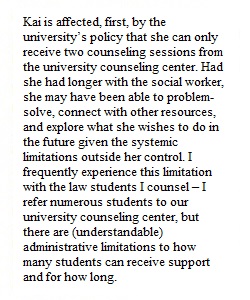


Q Instructions For this discussion, you will chose from one of the following vignettes from the Lane, Palley & Shdaimah textbook: 1. Larry’s case study (chapter 5, pp. 84-85) 2. Marcie’s case study (chapter 6, pp. 104-105) 3. Arvin’s case study (chapter 7, pp. 123-124) 4. Kai’s case study (chapter 8, p. 143) Based on what you know from the media or your personal, work, or volunteer experiences, think about the following questions as you read the case study vignette you chose. When you finish the vignette, answer the questions below. Prompt 1. Describe at least 2 specific policies that impact the people in the chosen case study. 2. What strengths and resources do the people in the case study have to draw on? 3. What role might race, class, gender, and other aspects of identity play in this vignette? ________________________________________ Requirements In order to successfully complete this discussion, you should: • Be concise. Your initial posts should be brief (approximately 250-500 words). However, you will be graded based on the quality of your answer. • Submit your initial post by the date specified on this page. • Respond to at least two of your peers by the end of the week. Your responses to your peers are participation-based. • You should cite at least two assigned readings from this module.
View Related Questions